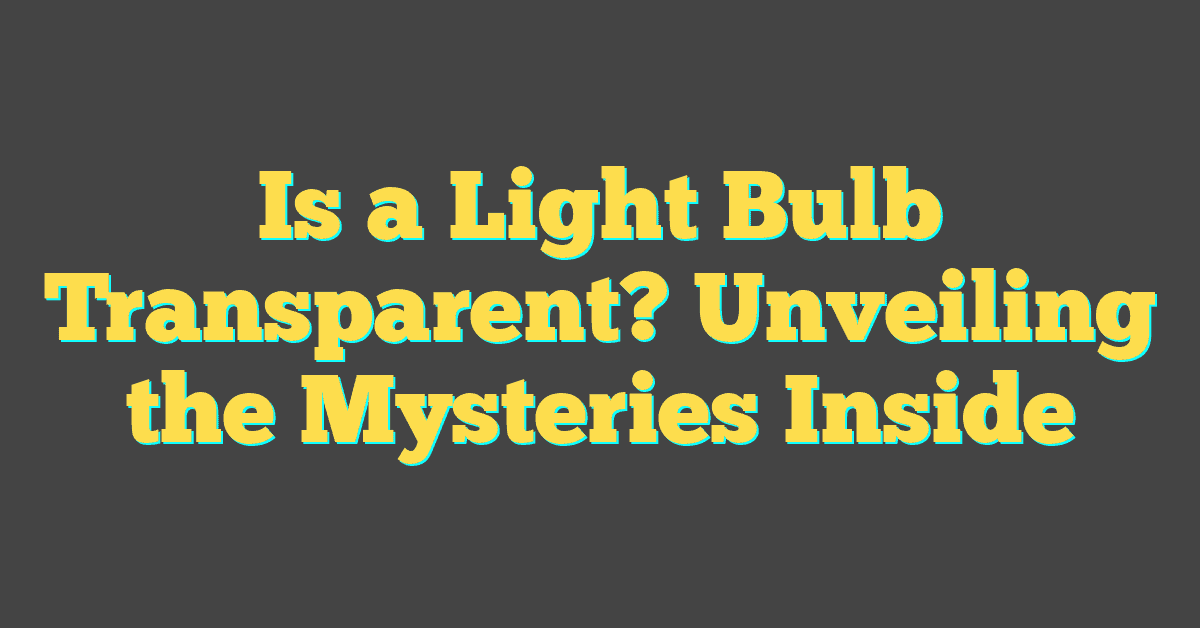Ever wondered if the humble light bulb is transparent? You flip the switch every day, but have you ever paused to consider what exactly lets that light flood your room? It’s a simple question, yet it’s packed with some illuminating science.

You might think it’s clear as day, but there’s more to a light bulb’s transparency than meets the eye. Let’s shed some light on the materials and design that make up these everyday illuminators and uncover the truth behind their see-through story.
What makes up a light bulb
If you’ve ever taken a moment during one of your home DIY projects to ponder what a light bulb is made of, you’re in for a revealing moment. At first glance, it’s the glass or plastic envelope that catches your eye, but there’s much more that goes into these illuminating wonders. Let’s unscrew the mystery and lay out the bare components that create the glow in your favorite reading nook or the bright ambience in your kitchen.
The Bulb’s Anatomy
The very essence of a light bulb stems from its anatomy:
- The Glass Envelope: Also known as the bulb, it’s typically made of silica and is the clear or frosted see-through component that encases the magic.
- The Filament: This is the heart of any incandescent bulb, a thin wire that glows bright when electrified.
- The Gas: Inert gases like argon or nitrogen fill the bulb to prolong the filament’s life by preventing it from oxidizing too quickly.
- The Base: It connects the bulb to the power source and is the unsung hero that validates the importance of compatibility.
While exploring your home for DIY enhancements or even crafting a handmade lamp, understanding these parts can inform your choices. The choice of material for the envelope, for example, influences how light diffuses throughout your space, while the type and quality of the base determine durability and ease of replacement.
Innovation at Play
Advancements in technology have added layers of complexity to these parts. LEDs, a common find in modern homes, forgo filaments for semiconductor chips and often use a mix of gases and heat sinks to manage temperature. With each leap in innovation, the light bulb evolves, and so does your power to shape the light in your environment.
Regardless of the bulb type, the interplay between these components dictates not only the light’s transparency but also its functionality and efficiency. The next time you’re on the hunt for the perfect bulb, spare a thought for the humble materials and sublime engineering that light up your life, from the throwback charm of Edison bulbs to the futuristic aura of smart LEDs. Your DIY skills, combined with a bit of insight into light bulb anatomy, will undoubtedly lead to brighter results.
The glass envelope

When you’re knee-deep in a DIY project or simply replacing a bulb, you might not give much thought to the glass that encloses the brilliance of your light bulb. Yet, the glass envelope is far more than just a shield; it’s a clear cocoon that nurtures and sustains the light within.
Crafted from silica, the glass envelope must strike a balance between being strong enough to withstand pressure and thin enough to ensure maximum transparency. The glass isn’t just selected at random; it endures a meticulous process where its thickness, clarity, and resilience are all fine-tuned. This design choice dramatically affects the bulb’s brightness and longevity.
The transparency of the glass allows light to pass through with minimal resistance, which is why it seems almost invisible when the bulb is lit. It is this very invisibility that makes it so crucial for achieving the bulb’s purpose: to illuminate your space without any distractions.
Inside this transparent barrier, inert gases play a covert role. These gases, often argon or nitrogen, are picked for their non-reactive properties, ensuring they don’t interfere with the filament’s performance. Argon is denser than air, so it helps reduce the evaporation of the filament, allowing your bulb to shine brighter for longer.
In modern bulbs, especially LEDs, the glass may undergo special treatments. Manufacturers may apply a phosphorescent coating inside the glass to enhance the light’s quality or color. The treatment captures some of the LED’s blue light and converts it into cozy, warm white light suitable for your living room or a more energetic, daylight hue perfect for your workspace.
Remember, while the glass envelope may seem merely protective, it actually completes your bulb, tailoring the light to fits your needs. Whether it’s the inviting glow in your reading nook or the bright beam on your workbench, that seemingly simple piece of glass has much to say about how well your space is lit.
The filament

« What Light Bulbs Have Yellow Light? Create a Cozy Home Glow
What Can You Use Instead of Light Bulbs? Discover Smart Lighting Alternatives »
When you’re delving into the heart of a light bulb, you’ll encounter the filament, a vital component that’s as intriguing as the glass envelope. The filament plays a pivotal role in the illumination process, effectively converting electrical energy into light.
Tungsten is the go-to material for most filaments due to its high melting point and durability, although you’ll find other materials in various types of bulbs. Tungsten stands out because it can withstand a lot of heat without melting away quickly, making your light bulb last longer.
The filament’s design and thickness are just as important as the material. These characteristics determine the temperature the filament reaches and, consequently, the color of the light emitted. A thinner filament might glow brightly and have a whiter light, whereas a thicker one would produce a softer, warmer glow.
Interestingly, the filament doesn’t work alone. It’s in a synergistic relationship with the glass envelope and the gas inside. The inert gases present, such as argon or nitrogen as previously mentioned, reduce the rate of tungsten evaporation. This helps preserve the filament and extend the life of the bulb.
In the realm of LEDs, the “filament” takes on a new form, as LED chips mounted on a substrate to mimic the look of traditional filaments. Although not a filament in the classic sense, this design bridges the gap between old and new, combining the rustic charm of early 20th-century bulbs with the efficiency of modern lighting technology.
For your DIY projects or when you’re on the hunt for the right light bulb, remember to check out the filament type and the related specifics on the packaging. Whether you’re creating a cozy ambiance or need bright light for task lighting, the filament can make all the difference in achieving your desired effect. Just another piece in the fascinating puzzle of light bulb anatomy, the filament truly is where the magic of light begins.
The gases inside

When you’re browsing for that perfect light bulb to fit your DIY fixture or brighten up your reading nook, it’s not just the shape or wattage that matters. What’s going on inside that glass envelope might not be visible, but it plays a critical role in the bulb’s performance. The gases inside a light bulb are like unsung heroes, working behind the scenes to make that warm or cool glow happen.
Traditionally, light bulbs have been filled with inert gases like argon and nitrogen. If you ever wondered why, it’s because these gases perform a crucial task – they protect the tungsten filament from oxidizing too quickly when it heats up. When you flip that switch and electricity surges through the filament, it gets white-hot. This would normally cause tungsten atoms to fly off and stick to the inside of the bulb, dimming it over time. The inert gases press against the evaporating tungsten atoms, preventing them from escaping and effectively prolonging the life of your light bulb.
With modern advancements, some bulbs now contain a mix of argon and krypton or xenon gases. Picture this: by tweaking the gas blend, manufacturers have managed to fine-tune efficiency and brightness. Krypton and xenon, being denser than argon, offer better protection for the filament. They also reduce heat loss and allow for a more concentrated light. This means more lumens per watt, which translates to more light for less energy, saving you money in the long run.
| Gas | Benefit |
|---|---|
| Argon | Slows filament wear |
| Nitrogen | Low-cost protection |
| Krypton | Increases efficiency |
| Xenon | Boosts light concentration |
But what about LED bulbs? They still use the concept of a sealed environment to protect the semiconductor materials inside. Here, the “gas” isn’t a gas at all, but rather a specific atmosphere or vacuum to safeguard the LED components that generate light in a completely different, yet efficient manner.
How light bulbs work

Ever wondered how the seemingly simple light bulb can transform your living room with a flick of a switch? Let’s shed some light on the magic that happens inside these fascinating devices.
At the heart of a light bulb is the filament, which is what glows and gives off light. When you flip the switch, electricity flows into the bulb and through the filament. Because the filament offers a bit of resistance to this electrical current, it heats up – a lot. This process, known as incandescence, is the same principle that makes a piece of metal glow when it’s hot enough.
As the filament reaches temperatures upwards of 2,500 degrees Celsius, it emits photons – those are tiny packets of light that are the fundamental particles of visible light. The material of the filament, typically tungsten due to its high melting point, is key to its ability to produce light without melting away quickly.
Yet, it’s not just the filament that’s crucial here – the gases around it play a pivotal role. As mentioned earlier, these gases protect the filament, but they also influence how efficiently the bulb produces light. For instance, the presence of gases like argon and krypton decreases the rate at which the tungsten evaporates, thus reducing the bulb’s wear and tear.
LED bulbs, on the other hand, work a bit differently. They rely on semiconductors and a process called electroluminescence. As you supply power, electrons move through a semiconductor material, releasing energy in the form of light as they go. This method doesn’t produce much heat, making LEDs incredibly energy-efficient.
In your many DIY projects, you’ve likely preferred LEDs for their longevity and efficiency, or perhaps the classic incandescent bulbs for their warmth and color. Either way, next time you’re swapping out a bulb or inspecting fixtures, take a moment to appreciate the ingenuity wrapped up in that simple glass sphere.
Conclusion
So now you’ve delved into the world of light bulbs and discovered they’re more complex than they seem. It’s fascinating to think about the intricate dance of gases and filaments that light up your world. Whether it’s the gentle glow of a traditional bulb or the energy-efficient shine of an LED, remember there’s a lot happening behind that luminous surface. Next time you flip a switch, you’ll have a new appreciation for the little wonders that brighten your day. Keep exploring and always stay curious about the everyday marvels around you!
Frequently Asked Questions
What types of gases are typically used in light bulbs?
Argon and krypton are commonly used gases inside light bulbs, as they help protect the filament and improve the bulb’s overall efficiency and longevity.
How does a light bulb’s filament work?
The filament in a light bulb heats up when electricity passes through it, causing it to emit photons, which we perceive as light.
What is the main role of gases in a light bulb?
Gases such as argon and krypton in light bulbs primarily protect the filament from oxidation and reduce wear and tear, thus extending the bulb’s life.
Do LED bulbs use gases like traditional light bulbs?
No, LED bulbs differ as they do not use gases. Instead, they utilize semiconductors and electroluminescence to produce light, resulting in minimal heat production.
Why should we appreciate light bulb technology?
Light bulb technology demonstrates significant ingenuity in its design and function, from the choice of gases used to protect the filament to the energy-efficient methods of producing light in LED bulbs.




